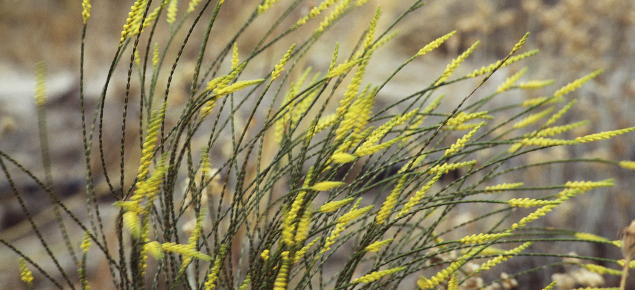Introduction
Golden cascade is entirely picked from natural populations and exported fresh to markets in Asia and Europe. Picking is banned on Crown Land and supplies of flowers are only available from managed bush stands on private property. Picking is done under licence with strict guidelines to ensure the plant’s conservation and sustainability.
DAFWA has developed methods to reliably propagate plants of golden cascade for cultivation. The plants take several years to reach their full potential in cultivation but the current high value of the flowers may compensate for the long lead times. Cultivating golden cascade opens up more reliable sources of flowers for exporting.
Bush management
The conditions set down for bush harvesting are summarised in Table 1.
| Requirements |
|---|
| Ban on all harvesting from Crown Land |
| Licences issued to properties where DPAW (formerly CALM) is satisfied harvesting is sustainable |
| Fire frequency for areas commercially harvested should be no more than eight to ten years |
| No more than 20% of available flowering stems taken in any one flowering season |
| Harvest technique must ensure leaves are retained below the pruning cut |
| Further surveys be undertaken to assess sustainability |
Following the above practices, bush picking has allowed sustainable harvests of stems. Stems are usually 60 to 90 centimetres long with 15 to 30 stems per bunch.
DAFWA selected at least one form that was high yielding than bush-picked plants, had a good propagation rate and good vase life.
Site selection
Golden cascade prefers sand over gravel, and warm, dry climates with average minimum-maximum temperatures of 12 to 23°C. Growing on deep sands requires precise irrigation practice. The site chosen should be free of diseases, particularly dieback (Phytophthora spp.), and weed-free, as plants do not compete with weeds during establishment.
Planting and establishment
Plants are best planted in spring (September to October) when risk of frost has passed. Plant earlier in drier locations or dry seasons.
Plants perform better on sandy soils with a bare, weed free sandy surface. Windbreaks such as grow cones, or similar individual plant guards are useful in the first six months of establishment. Once guards are removed it may be necessary, on windy sites, to support plants for the first year.
Plants are best established at high density of 9,500 to 13,200 plants per hectare, depending on the selection used. This can be achieved by planting in a double row with rows 0.6 metre apart and 0.5–0.7 metres between plants in an alternating pattern.
Plants do not benefit from mulch. Instead, the soil surface should be kept bare. This allows deeper penetration of irrigation water via micro-sprays. The soil surface surrounding the plant must be kept free from weeds by regular spraying or hand-weeding.
Fertilisers
At planting, 5 grams of low phosphorus, slow release fertiliser, such as Osmocote or Nutricote, should be spread on the soil surface next to plants. Six months after planting, a further 10 grams of low phosphorus, slow release fertiliser should be spread on the soil surface in a 30 centimetre radius around each plant.
Repeat this every six months. By this method plants should receive about 40kg/ha/annum of nitrogen, 25kg/ha/annum of potassium and 6kg/ha/annum of phosphorus and calcium with a balance of trace elements.
Irrigation
Micro-sprays are preferred to trickle irrigation as they allow the whole soil profile to be wet evenly. Irrigated plants of golden cascade at Medina have a low evaporation replacement of 20–30%. Tensiometers can be used to schedule irrigation. Enough water is then applied to recharge the root zone to a predetermined reading on the tensiometer gauge. Install tensiometers at 15 centimetres directly below the plants. Tensiometer readings should be monitored daily and once it has reached 12-14cb, turn on micro-sprinklers for one to two hours (delivering 14L/m2/h).
After irrigation, wait an hour and then check tensiometers again, and if necessary turn on sprinklers again until reading returns to wet (less than 5cb). At Medina during October to April it was enough to irrigate plants about once a week. From May to September rainfall was sufficient to keep tensiometers within the prescribed limits.
Pruning
Plants respond to light pruning in the first year and this is necessary to establish a good branch structure. Do not pick to bare wood and make sure you leave a green stem below the pruning cut.
Pest and diseases
Few pests and diseases appear to affect golden cascade, however, in wetter areas they may be a problem and it would pay to closely monitor plants.
Botrytis has not been detected on this flower.
Postharvest treatment
No special vase solutions are necessary, although good postharvest practice is necessary to prevent petal loss, particularly in bush-picked material. Stems should be stood with their ends in clean water after picking to maximise vase life and quality. No anti-ethylene treatment such as STS is necessary.
After picking, flowers should be cooled quickly to 2°C and kept below 5°C once packed to maximise quality. Flower bunches of 15 to 30 stems, 60 to 80 centimetres long can be densely packed into flower cartons.
Acknowledgments
The support of the Australian wildflower industry and funding from Golden West Flowers, the Rural Industries Research and Development Corporation and CALM to carry out this work is gratefully acknowledged.


